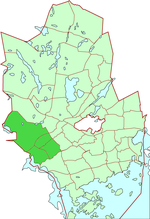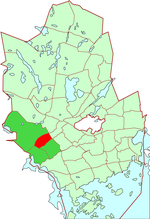Saunalahti (Finnish) or Bastvik (Swedish) is one of the newest apartment building districts in Espoo, Finland, located by the Kummelivuori hill between Kivenlahti and Kurttila, west of the Kauklahdenväylä road, on the coast of the Espoonlahti bay. The bay at Saunalahti is named Bastvikfjärden. The area also contains original detached house residence from old Saunalahti and agriculture. Saunalahti is separated from Kivenlahti by the Länsiväylä highway, continuing to Kirkkonummi as Jorvaksentie.
The Bastvik manor, dating back to the 19th century, has long since fallen into disrepair. In 2005, the city has started renovating it, and it is planned to host the office of the renovation project architects (Arkkitehtitoimisto Okulus Oy), a café, and a home. The Bastvik projekt includes research of old construction and manufacturing techniques. At some point, Bastvik was planned as a remote facility of the apartment fair held in Kauklahti in summer 2006. However, the plan was abandoned.
The Bastvik manor had a significant sawmill in the 19th century, and because of this, Sågholmen (formerly an island, currently the Sahaniemi peninsula) has been a stopping place for large ships. In the late 1910s, the manor building suffered from lack of management, but in 1923 the farm was bought by Claes Nordstedt, the founder of the Kauklahti glass works, who renovated the building. When the Kauklahti glass works went into bankruptcy, Nordstedt sold the farm to banker Antti Hiltunen and his family in 1928. Hiltunen had the manor building renovated again, this time also architecturally. By the plans of architect Väinö Toivio, the building got a neo-classical, villa-style look. The current 2000s renovation project of the manor building aims to preserve this 1920s spirit.
The Espoo rantaraitti route is planned to extend all the way to Saunalahti. At this moment, the coast of Saunalahti is, except for a few small exceptions, not accessible to the public.






